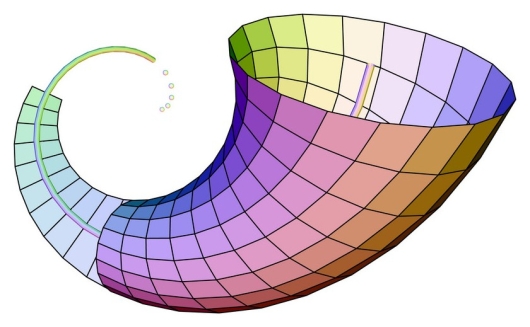This image was originally developed as the focal point of the National Mathematics Awareness Month poster of April 2000. The theme was “Math Spans All Dimensions”. It was too lovely to be retired, and appeared again to commemorate 47 years of teaching mathematics at Brown University by Emeritus Professor and geometer Thomas Banchoff.

According to the artist, it is suffused with joy, just as I had hoped! It begins with mere points, then a curve that flares into a spiral, and eventually a colorful 3-D cornucopia of mathematical plenty:
suggesting the possibility of further dimensions yet to come.
I encourage paying a visit to the mathematical artwork page. There are Klein bottles, sliced torii, the spectacular Steiner’s Roman Surface and much more to be found there.

Roman Surface
April 2020 was the scheduled date for the most recent National Mathematics and Statistics Awareness Month. It is a biannual event, i.e. held once every two years. Sadly, it was uniquely ill-timed to coincide with the arrival of the COVID-19 global pandemic.
Possibly even worse is the fact that I saw no mention of any activities for 2022. I noticed this while browsing through the pages of the Mathematical Imagery SIG (special interest group) of the American Mathematical Society (AMS).
On the origins of Mathematics Awareness Month
As any blog reader of mine knows, I strive to find surprising information. The origin of AMS’s Mathematics and Statistics Awareness Month can be traced back to none other than… Ronald Reagan? Yes, former U.S. President Reagan established the event in 1986, by Presidential Proclamation, with the following announcement:
Despite the increasing importance of mathematics to the progress of our economy and society, enrollment in mathematics programs has been declining at all levels of the American educational system. Yet the application of mathematics is indispensable in such diverse fields as medicine, computer sciences, space exploration, the skilled trades, business, defense, and government. To help encourage the study and utilization of mathematics, it is appropriate that all Americans be reminded of the importance of this basic branch of science to our daily lives.
—via President Ronald Reagan in Proclamation 5461 – National Mathematics Awareness Week (PDF), April 17, 1986
If Reagan had only known what would happen in the future maybe he would have made it an executive order instead of a mere proclamation.
Professor Banchoff’s art work has even graced some book covers, including this one, written by my favorite statistician.







